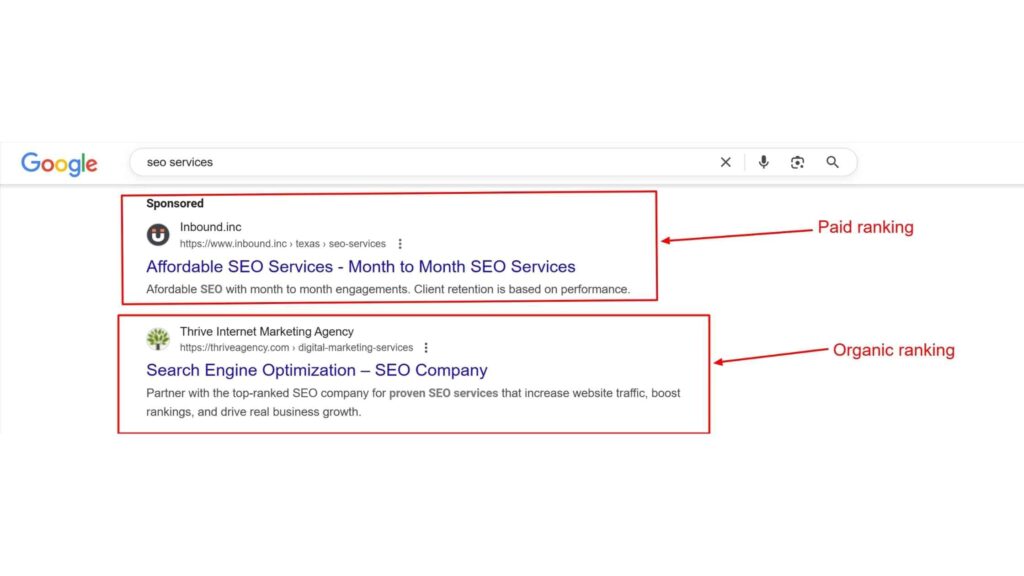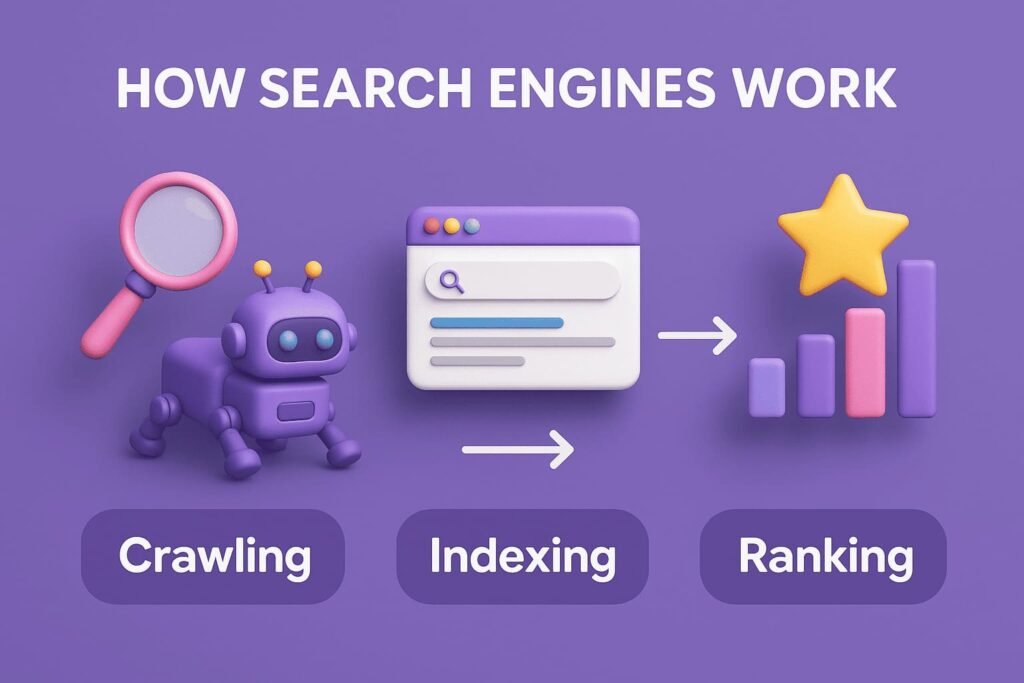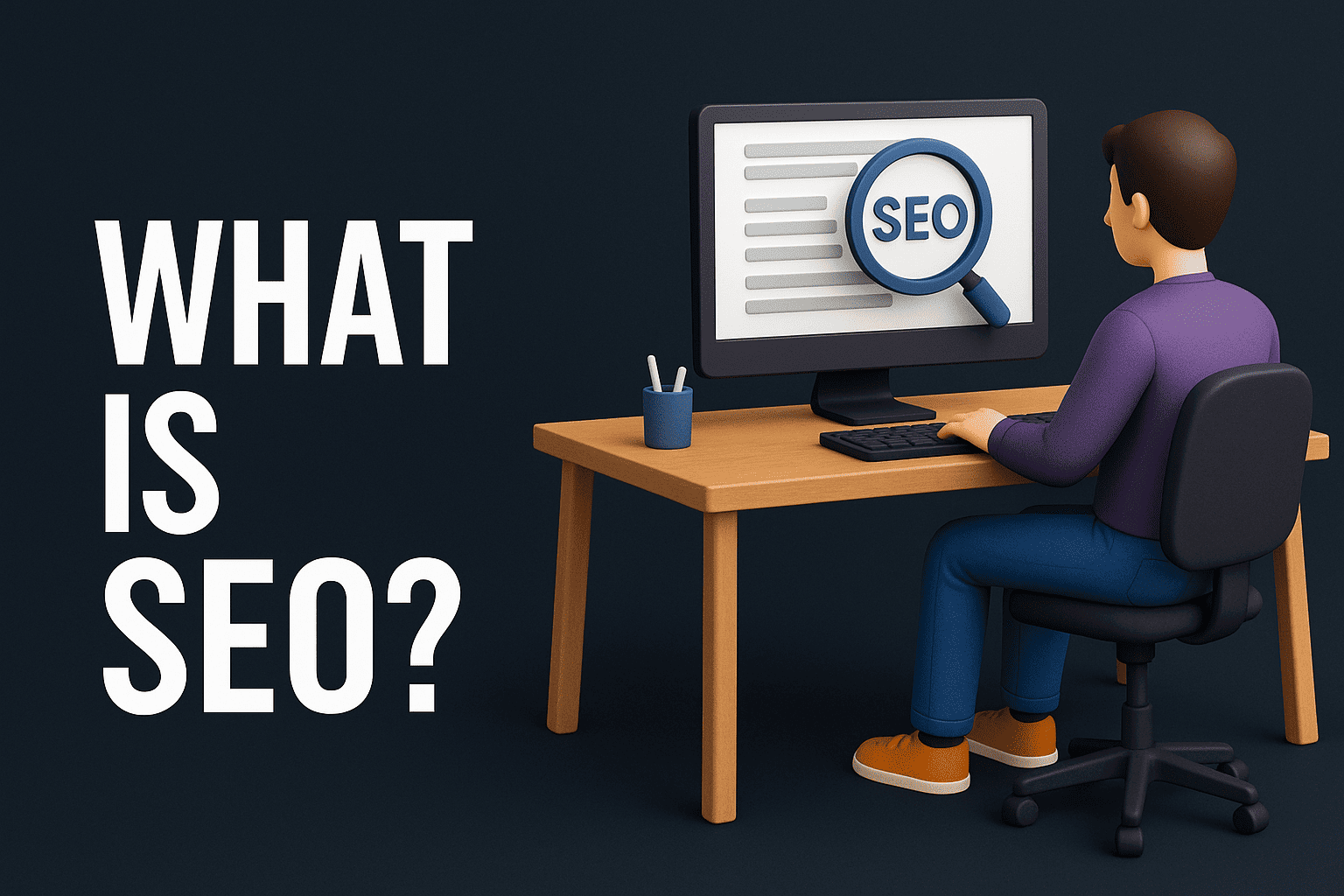Search engine optimization (SEO) is the practice of shaping your website so that search engines like Google can find, understand, and share it. When SEO is done well, your pages appear higher in search results for the words people actually type. More visibility means more visitors, and more visitors often mean more leads, sales, or sign-ups.
Organic search remains a major source of traffic. Data from 2024 showed that over 53% of all website visitors came from search engines. That makes SEO one of the best ways to grow a site without paying for ads. In this guide, you’ll see how SEO works under the hood and learn clear, step-by-step methods to make your site faster, easier to use, and more helpful to readers.
What Is SEO?
At its heart, SEO is about three things:
- Helping search engines crawl your pages.
- Making sure your content matches what people are looking for.
- Earning trust by building links and offering a good experience.
SEO differs from paid ads because it focuses on organic search results. These are the unpaid listings that show up after any ads. When you rank organically, you get clicks without a cost per click.

How Search Engines Work
Search engines run in three steps:
- Crawling: Bots follow links on your site and other sites to find every page.
- Indexing: They store the words, images, and video files in a giant library.
- Ranking: When someone searches, the engine pulls the best matches and ranks them.

Ranking depends on factors like relevance (how well your content answers the query), page speed, security (HTTPS), mobile-friendliness, and how long people stay on your page. Knowing these steps lets you shape your site so it’s easy for bots and users alike.
Why SEO Matters Today
- Steady Traffic Source: Organic search supplies around half of site visits.
- Cost Savings: You don’t pay each time someone clicks.
- User Trust: Pages on the first results page carry more weight in a user’s mind.
A 2024 user study reported that 75% of searchers never go past page one of results. If you’re not there, you miss out on most potential clicks. Good SEO makes sure your content appears where people expect to find it.
Core Types of SEO
On-Page SEO
On-page SEO is all the work you do on your own pages:
- Title Tags & Meta Descriptions
Write clear, helpful descriptions that include your main term—like “search engine optimization”—early on. - Headings (H1, H2, H3)
Use headings to break up text and include related phrases such as “organic traffic strategies” or “keyword research tools.” - Content Quality
Share real insights and practical examples. For instance, show a quick audit of a sample page and point out tweaks. - Image Alt Text & URLs
Describe images in a few words (“SEO audit checklist”) and use simple URLs (e.g., yoursite.com/complete-seo-guide).
Technical SEO
Technical tips help search bots move through your site without hitting dead ends:
- Page Speed
Compress images, reduce server response time, and enable browser caching. - Mobile-First Design
Make sure buttons, text, and menus work well on phones and tablets. - Secure Site (HTTPS)
A locked padlock icon in the address bar tells users and bots your site is safe. - XML Sitemaps & robots.txt
A sitemap lists every page you want indexed. A robots.txt file tells bots which parts to skip. - Structured Data (Schema.org)
Tag details like reviews, recipes, or events so search engines can show extra info (rich snippets) in results.
Off-Page SEO
Off-page SEO is about building a good reputation on the wider web:
- Backlink Building
Earn links from sites in your niche by writing guest posts or creating resources they’ll cite. - Social Signals & Mentions
If people share or mention your content on social media, you’ll get more links and more visitors. - Influencer Outreach
Partner with experts to co-create content or conduct interviews that drive new visitors back to you.
Content SEO
Content fuels almost every SEO effort:
- Formats That Work
Long-form articles, how-to videos, infographics, podcasts—each serves a different need. - Keyword Focus
Short-tail terms (e.g., “SEO”) attract high search volume but more competition. Long-tail phrases (e.g., “WordPress SEO audit checklist”) often drive more targeted visits. - Topic Clusters
Group several related posts around one main “pillar” page. This shows search engines you’ve covered the topic in depth.
Keyword Research Strategies
- Pick the Right Tools
Try Google Keyword Planner for cost-free data, and platforms like Ahrefs or SEMrush for detailed trend and difficulty insights. - Spy on Competitors
Look at top pages in your area. Note the terms they rank for and the kinds of content they publish. - Match User Intent
Organize keywords by intent categories: informational (questions), navigational (specific sites), commercial (product comparisons), and transactional (buy now). - Use LSI Terms
Add semantically related phrases such as “search ranking factors” and “SEO audit checklist” to help search engines see the full picture.
Writing for People and Search Engines
- Simple, Clear Style
Aim for short paragraphs, active voice, and real examples (e.g., “Here’s how we boosted page speed by 40% in two weeks”). - NLP-Friendly Content
Include named entities (brands, research names, tool names) and natural language patterns so search engines better grasp your topic. - Expert Voices
Quote specialists. For example: “Focusing on user questions is the fastest path to better rankings,” says Jane Doe of BrightSEO.
Measuring SEO Success
To know if your work pays off, track:
- Organic Traffic
Visits from search engines, week over week and month over month. - Bounce Rate & Time on Page
A low bounce rate and longer time on page often mean content matches what people want. - Keyword Positions
Use rank-tracking tools to watch your target keywords move up or down. - Conversions
Whether it’s form fills, sign-ups, or sales, link conversions back to organic sessions.
Set up Google Analytics and Google Search Console. Pull basic reports every month and compare to past performance to spot what’s working and what needs more effort.
SEO Tools and Resources
- Free Tools
Google Search Console, Bing Webmaster Tools, AnswerThePublic for question ideas. - Paid Platforms
Ahrefs, SEMrush, Moz Pro offer deeper audits, backlink analysis, and site health scores. - WordPress Plugins
Yoast SEO and Rank Math guide you on-page with live feedback. - Learning Hubs
Keep an eye on blogs like Search Engine Land, Neil Patel, and Google’s own SEO guide for updates.
Emerging Trends in SEO (2025)
- AI-Assisted Content
Writers use AI to outline topics, find gaps, and even suggest opening paragraphs. - Voice & Visual Search
More people speak queries or use images. To rank, include natural speech patterns and image alt text that describes scenes. - Page Experience Signals
Google’s Core Web Vitals—loading speed, interactivity, and visual stability—are now ranking factors.
Advanced Tips and Expert Insights
- Content Clusters
Link related posts to a single pillar page. This builds a clear structure and shows depth on a topic. - Local & International SEO
For local, keep your Google Business Profile current. For multi-country sites, use hreflang tags so each visitor sees pages in their language. - Expert View “Solve a real problem for your reader, and search engines will follow,” notes John Smith of SEO Experts United.
Common SEO Mistakes to Avoid
- Keyword Stuffing
Overloading text with the same terms makes it hard to read and can incur penalties. - Ignoring Mobile Users
A clunky mobile site loses half of your audience. - Skipping Analytics
Without data, you can’t prioritize improvements or prove ROI.
Conclusion
SEO is a marathon, not a sprint. By improving on-page elements, fixing technical issues, building meaningful links, and creating content that answers real questions, you’ll increase your visibility and attract more of the right visitors. Start with a simple audit, pick your top three fixes, and watch your traffic grow over the next few months.
FAQs
What’s the difference between on-page and off-page SEO?
On-page SEO covers changes you make on your site—content, tags, markup. Off-page SEO is about actions off-site, such as earning backlinks and social shares.
How long until I see SEO results?
Most sites notice improvements in 3–6 months. Very new sites or competitive niches may take longer.
Are backlinks still a top factor in 2025?
Yes. Quality links from relevant, authoritative sites remain one of the strongest signals for search engines.
Should I hire an SEO expert or do it myself?
For small blogs, free tools and guides can get you started. In competitive fields or for large sites, an experienced consultant can speed up results.
